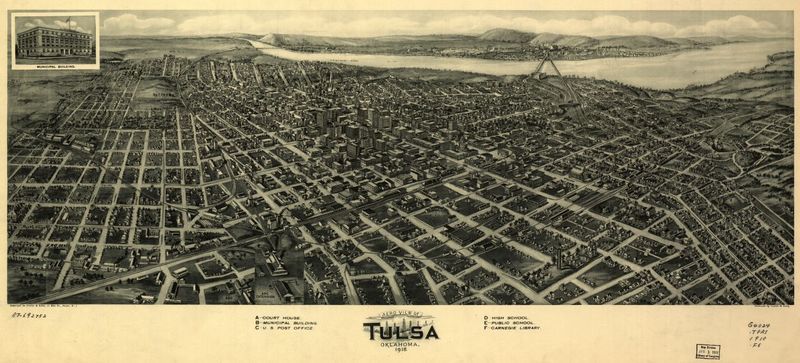Contributors
This project was collaboratively produced in AMST3683 Introduction to Digital Humanities at Oklahoma State University in the Spring of 2021 (graduate student took the course under the prefix ART 5850 Topics in Graphic Design). The course utilized a focus on race, justice, and technology to orient our approach to digital skills-building. The exhibit was the capstone of that experience and our small contribution to the remembrance of the survivors on the eve of its 100th anniversary. The assignment was this:
Together, we will be building an online exhibit, which will highlight and contextualize the Tulsa Race Massacre (TRM) artifacts available in the Ruth Sigler Avery collection at the OSU Tulsa library. . . . The aim of the project will be to make the resources contained in the archive more accessible and usable for the public. . . .
You will use Tim Madigan’s The Burning, and a variety of other scholarly and community resources, including guest lectures, to inform your understanding of the race massacre and its aftermath. It will be up to the class as a whole to design an exhibit that pays respect to the massacre but also to what Dr. Alicia Odewale, who is leading the TRM archeology project, calls “signs of life” in the community. The ultimate aim of the project will be to tell the story of present-day Greenwood through these archival materials.
While we were unable to include a proposed page on Greenwood Rising, we hope that future courses can and will build on the exhibit, providing fresh insight and celebrating the legacy of resilience demonstrated by members of the Greenwood community in Tulsa, OK.
Contributors include:
AMST3683 Intro to Digital Humanities, Spring 2021
- Christopher Hopper, Senior, History major/Philosophy minor -- "Black Wall Street" and "Tulsa Burning "
- Alex Ray, Junior, Economics major -- The wonderful timeline on the home page
- Cristine Segui-Harris, Junior, American Studies major -- "The Voices of the Massacre"
- Tatum Wright, Sophomore, Biology major -- "Tulsa Race Massacre Resources"
ART5850 Topics in Graphic Design, Spring 2021
- Adam Glover, MFA student in Creative Writing -- "Cinders in the Sky"
- Hannah Bingham Brunner, PhD student in Applied Linguistics -- "Changing Frames: Riot or Massacre?"
Our fabulous Omeka guru is:
- Megan Macken, Digital Scholarship Librarian, Edmon Low Library, OSU
Special thanks to the following guest lecturers and guides (in alphabetical order):
- Quyrash Ali Lansana, poet, activist and Tulsa Artists Fellow, who shared his expertise on the Greenwood community, the history of racism in Oklahoma, and the still unmet need for reparations in North Tulsa.
- Moya Bailey, Assistant Professor of Africana Studies and Women's, Gender, and Sexuality Studies at Northeastern University, who shared her knowledge of digital culture and #hashtag activism with students during a wonderful set of sessions organized by Jennifer Borland, Director of OSU's Digital Humanities Initiative.
- Madison Chartier, Metadata Specialist, Digital Resources and Discovery Services (DRDS), Edmon Low Library, OSU, who helped us learn more about how metadata works and why it matters. Thanks for organizing the metadata exercise with such efficiency and aplomb!
- Kevin Dyke, Maps and Spatial Data Librarian, Edmon Low Library, OSU, who helped us learn to be skeptical of GIS and other maps. Now we know maps can also lie!
- Kathy Essmiller, Open Educational Resources Librarian, Research & Learning Services Division, Edmon Low Library, OSU, who enhanced our understanding of Creative Commons licensing
- Clarke Iakovakis, Scholarly Services Librarian, Research & Learning Services, Edmon Low Library, OSU, who helped us understand copyright and fair use
- Holly Reiter, Director, Library Teaching & Learning, Edmon Low Library, OSU, who introduced us to the joys of SIFT-ing information for accuracy and trustworthiness.
- Megan Macken, Digital Scholarship Librarian, Edmon Low Library, OSU, who wore many hats, including tech guru, database specialist, and Omeka-S trouble-shooter, and without whom we literally could not have pulled this off. Thanks, Megan!
- Sarah Milligan, Head of the Oklahoma Oral History Research Program, Edmon Low Library, OSU, who shared her wealth of knowledge about oral history and the ethics of collecting, describing, archiving, and publicizing materials related to traumatic historical events.
- Sheena Perez, Digital Services Librarian, OSU-Tulsa Library, who oversees the Ruth Sigler Avery Collection, helped coordinate our metadata assignment, and provided invaluable insight on the Omeka-S project in draft form.
- Sean Thomas, PhD Candidate in Geography, who shared his amazing GIS mapping project of Greenwood with us and waited patiently while we tried to help him digitize the hand-written fire insurance records upon which the map builds.
- Matt Upson, Associate Dean, Research & Learning Services, Edmon Low Library, OSU, who organized the informative screening and discussion of Coded Bias, which the students participated in.
- Lynn Wallace, Director of the OSU-Tulsa Library and the inspiration for the final project. Lynn's insights into the course were numerous and her input proved essential during the final phases of the exhibit's creation. I'm glad you like the final product!
- Brandy Wells, Assistant Professor of History, OSU, whose advice was invaluable in helping me plot a course through the course.
The official curator of this learning enterprise was:
- Stacy Takacs, Professor of English and American Studies, part-time DH afficionado, full-time fan of Digital Pedagogy and Digital Literacy
